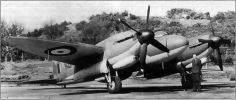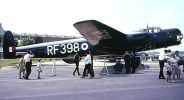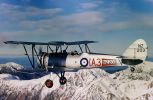
vickersf741438 views
|
|

Avro Lincoln436 viewsHeavy bomber developed from the Lancaster, and initially known as the Lancaster B Mk.IV. The Lincoln, bigger and with a longer range, was developed for a British campaign in the far East, but was never used in this role because of the end of WWII. It compared unfavourably with more modern designs like the B-29, but was kept in service until 1963 and saw in combat over Kenya and Malaya. One was shot down on its way to Berlin in 1957.
|
|

AVRO 626433 viewsThe Avro 626 was developed in 1930 from the Tutor with an optional third seat in a rear cockpit with provision for a gun ring. Numerous sales were made to foreign air forces up to 1939, some of which survived in second-line service until 1945. At least two 626s survived in Belgium's Aeronautique Militaire until 1940.
Avro Prefect: The RAF bought seven Tutor/Avro 626 hybrids, two-seaters with Lynx IVC engines, to Specification 32/34 as navigation trainers for service at School of Air Navigation, Andover. Delivered in 1935, they operated during WWII on miscellaneous duties. Four Lynx-engined Prefects supplied to RNZAF in 1935 were three-seaters; one survived to 1945.
|
|

Avro Lincoln419 viewsHeavy bomber developed from the Lancaster, and initially known as the Lancaster B Mk.IV. The Lincoln, bigger and with a longer range, was developed for a British campaign in the far East, but was never used in this role because of the end of WWII. It compared unfavourably with more modern designs like the B-29, but was kept in service until 1963 and saw in combat over Kenya and Malaya. One was shot down on its way to Berlin in 1957.
|
|

Avro Lancaster409 viewsThe Lancaster bomber was one of the most famous bombers of World War 2 its bomb load exceeding that of any other aircraft in full-scale production at the time. Only two examples are flying at the present time although there are several static examples in existence. With four Rolls-Royce Merlin engines giving a top speed of 287 mph and a range of 1,660 miles, the Lancaster’s’ seven-man crew could provide a knockout punch with a typical load of 18,000 pounds of high explosive over the target. Along with the Handley Page Halifax, the Lancaster gave the UK the offensive striking power needed to penetrate German air defenses during World War II.
|
|
|
|
|